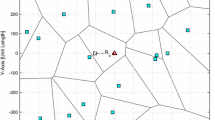Abstract
In this paper we determine the probability distribution function of cumulated instantaneous interference power in a mobile radio network, when the positions of interfering stations are distributed according to a one‐ or two‐dimensional Poisson point process, truncated at a finite horizon. The influences of Rice and Rayleigh fading, lognormal shadowing, near far effect and capture are taken into account. From the resulting distribution the probability of successful transmission and corresponding bit‐error‐rates are derived.
Similar content being viewed by others
References
R.C. French, The effect of fading and shadowing on channel reuse in mobile radio, Transactions on Vehicular Technology 28(3) (August 1979) 171–181.
D.J. Goodman and A.A.M. Saleh, The near/far effect in local ALOHA radio communications, Transactions on Vehicular Technology 36(1) (February 1987) 19–27.
F. Hansen and F.I. Meno, Mobile fading – Rayleigh and lognormal superimposed, Transactions on Vehicular Technology 26(4) (November 1977).
R. Hager, R. Mathar and J. Mattfeldt, Intelligent cruise control and reliable communication of mobile stations, Transactions on Vehicular Technology 44(3) (August 1995) 443–448.
J.P. Linnartz, A.J. T Jong and R. Prasad, Effect of coding in digital microcellular personal communication systems with co-channel interference, fading, shadowing and noise, IEEE Journal on Selected Areas in Communications 11(6) (August 1993).
R. Mathar and J. Mattfeldt, On the distribution of cumulated interference power in Rayleigh fading channels, Wireless Networks 1 (1995) 31–36.
R. Mathar, J. Mattfeldt and R. Hager, Analysis of mobile packet radio networks in Rayleigh fading environments, IEEE Transactions on Vehicular Technology 43(4) (November 1994) 1112–1117.
R. Prasad, Performance analysis of mobile packet radio networks in real channels with inhibit-sense multiple access, Proceedings of IEE 138(5) (October 1991) 458–464.
R. Prasad and C.-Y. Liu, Throughput analysis of some mobile packet radio protocols in Rician fading channels, Proceedings of IEE 139(3) (June 1992) 297–302.
T.S. Rappaport and C.D. McGillem, UHF fading in factories, IEEE Journal on Selected Areas in Communications 7(1) (January 1989) 40–48.
K.J. Zdunek, D.R. Ucci and J.L. Locicero, Throughput of nonpersistent inhibit sense multiple access with capture, Electronics Letters 25 (January 1989) 30–32.
Rights and permissions
About this article
Cite this article
Hellebrandt, M., Mathar, R. Cumulated interference power and bit‐error‐rates in mobile packet radio. Wireless Networks 3, 169–172 (1997). https://doi.org/10.1023/A:1019149015867
Issue Date:
DOI: https://doi.org/10.1023/A:1019149015867




